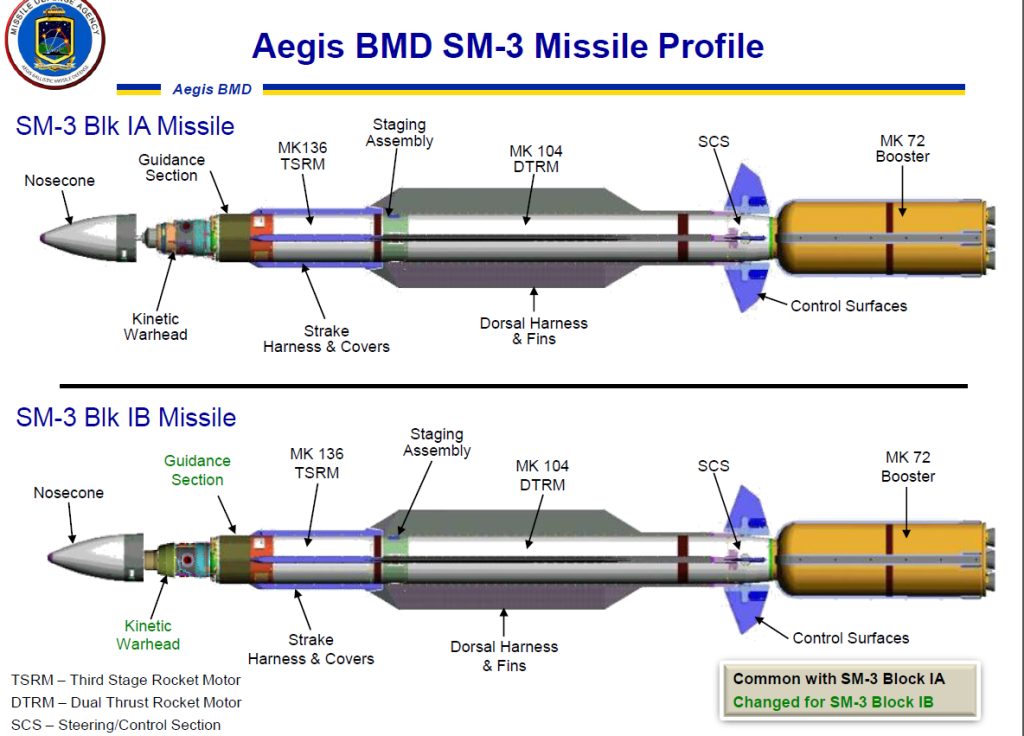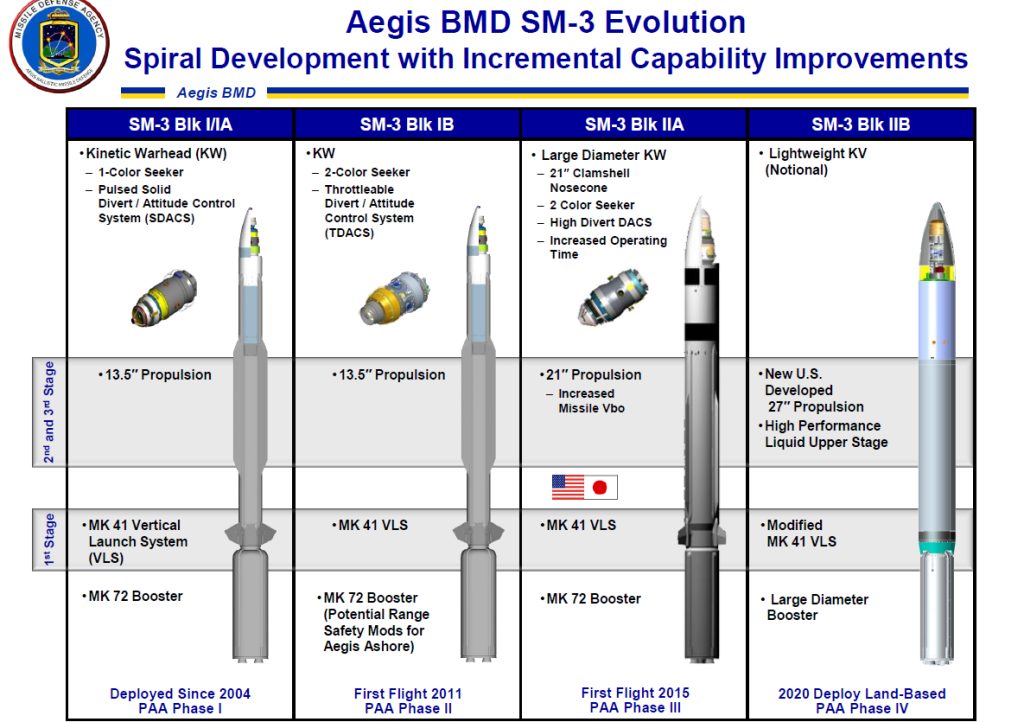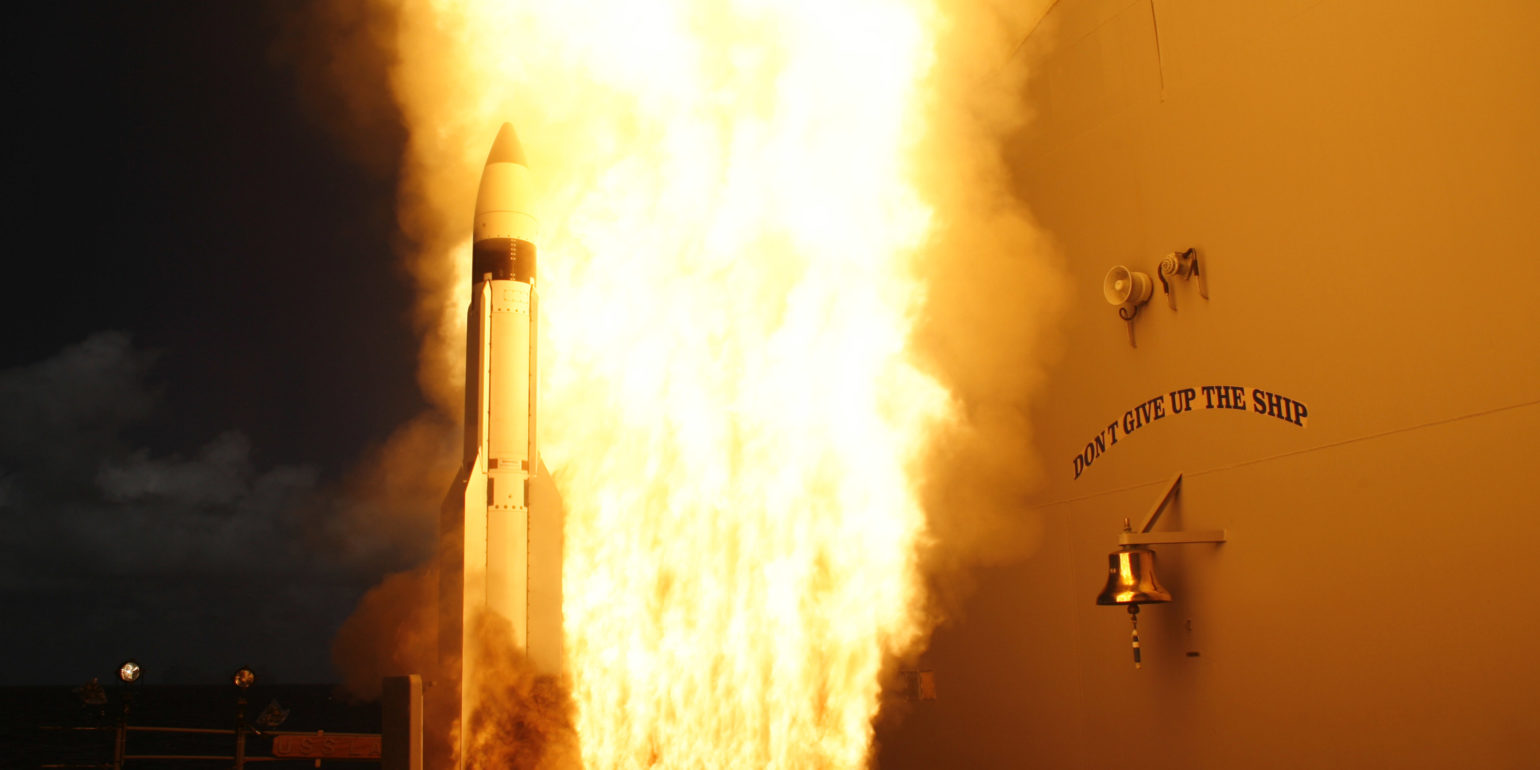Quick Facts
| Mobility | Sea- and land-based |
| Targets | Short-, intermediate-range ballistic missiles; satellite interception capable |
| Role | Area, eventually all phases of missile defense |
| Producer | Raytheon |
| Components | Shipboard SPY-1 radar Command and control systems |
Overview
The Standard Missile-3 (SM-3) is a derivative of the RIM-156 Standard SM-2 Block IV missile, and is the interceptor component of the U.S. Navy theater ballistic missile defense system, called NTW-TBMD (Navy Theater Wide – Theater Ballistic Missile Defense). It is an upper-tier (exo-atmospheric) ballistic missile defense weapon designed to intercept short- to intermediate-range ballistic missiles in the midcourse and terminal phases of flight. The SM-3 was originally planned to complement the lower-tier SM-2 Block IVA until the latter was canceled in December 2001. However, modern Aegis software has allowed the SM-3 to work in cooperation with lower-tier SM-2 and SM-6 air defense missiles.
The SM-3 missile, designated RIM-161A, uses the basic SM-2 Block IVA airframe and propulsion, and adds a third stage rocket motor (a.k.a. Advanced Solid Axial Stage, ASAS, made by Alliant Techsystems), a GPS/INS guidance section (a.k.a. GAINS, GPS-Aided Inertial Navigation System), and a LEAP (Lightweight Exo-Atmospheric Projectile) kinetic warhead (a non-explosive hit-to-kill warhead). The SM-3 interceptor replaced the SM-2’s explosive warhead and radar seeker with an additional solid-fueled third-stage motor and infrared homing kinetic kill vehicle, otherwise known as a LEAP.
The LEAP uses a Forward Looking Infrared (FLIR) sensor to locate its target, and was tested in 4-flight series called Terrier/LEAP from 1992 to 1995. These tests used modified Terrier and Standard Missile-2 missiles. Two intercepts were attempted during these tests, but the LEAP failed to hit the target in both cases. The first flight-test of an RIM-161A SM-3 missile occurred in September 1999, and the third test (in January 2001) demonstrated successful missile flight and control up to fourth stage (i.e. kinetic warhead) separation. In January 2002, the first all-up test of an SM-3 succeeded in intercepting an Aries ballistic target missile. For up-to-date information on testing, see the “U.S. Missile Defense Intercept Test Record” section of our web site. SM-3 has successfully achieved 28 out of 36 intercepts during tests including the satellite shoot down in February 2008.
SM-3 Variants
- SM-3 Block I This SM-3 variant was a limited production version that provided the first operational Aegis BMD intercept capability in 2005, when the USS Lake Erie conducted an intercept test. Only eleven were built, and four of these were used during tests.
- SM-3 Block IA The Block IA variant of the SM-3 is designed to intercept short- and intermediate- range ballistic missiles, incorporating rocket motor upgrades and computer program modifications to improve sensor performance and missile guidance and control. The Block IA is the first production version of the SM-3, being deployed on the USS Shiloh in 2006 as part of the Aegis BMD 3.6 deployment. The SM-3 Block IA interceptor is employed by Aegis BMD 3.6 vessels.
- SM-3 Block IB This SM-3 variant became operational in 2014, and has an enhanced two-color infrared seeker and upgraded steering and propulsion capability that uses short bursts of precision propulsion to direct the missile towards incoming targets. The new two-color sensor provides the capability to sense infrared information in two distinct wavebands, improving the identification of multiple objects. A throttleable Divert Altitude Control System (TDACS) provides the SM-3 IB with more post-launch maneuverability than its predecessors. Overall, the Block IB variant is capable of engaging ballistic missile targets at longer range with increased threat discrimination and is equipped by Aegis BMD 4.0 vessels.

- SM-3 Block IIA This SM-3 variant is being jointly developed and tested by the United States and Japan, and is expected to be deployed operationally and equipped by sea- and land-based Aegis BMD 5.1 systems in 2018. The interceptor will have new second and third rocket stages, allowing it to travel at much higher speeds than Block I missiles. Although the Block IIA is designed to counter short- to intermediate- range threats, the missile’s enhanced speed provides it with a limited capability against Intercontinental-range ballistic missiles as well. The Block IIA will have a new kill vehicle with heightened seeker sensitivity, increased divert capability, and longer operating time once released from its booster rocket. Although it is still in the testing phase, Phase III of the European Phased Adaptive Approach calls for employment of the SM-3 Block IIA in Europe by 2018.
- SM-3 Block IIB (cancelled) Prior to its cancellation in 2013, the SM-3 Block IIB was designed specifically for the Fourth Phase of the European Phased Adaptive Approach, which was scheduled to be carried out sometime after 2020. This missile variant would have had an even higher speed booster than the Block IIA and would be equipped with a lighter kill vehicle, making it ideal for intercepting faster moving and longer range ICMBs.

The European Phased Adaptive Approach (EPAA)
Aegis BMD and the SM-3 make up the foundation of the EPAA. Each phase of the EPAA calls for the deployment of upgraded SM-3 variants to counter the improving ballistic missile capabilities of Iran. In March 2011, Phase I of the EPAA mandated the deployment of 113 SM-3 Block IA interceptors and 16 SM-3 Block IB interceptors to Aegis BMD ships in Europe.
In 2015, Phase II called for 100 SM-3 Block IB interceptors to be deployed in Europe alongside the new Aegis Ashore site in Romania. The new land-based version—Aegis Ashore—is configured as Aegis BMD 5.0 with SM-3 IB interceptors. Aegis BMD 5.0 does not add new functionality, but is designed to integrate Aegis BMD 4.0.1 with the Navy’s open architecture system, enabling any Aegis ship to perform the BMD mission.
Scheduled for 2020, the third phase of the EPAA mandates the deployment of 19 new SM-3 Block IIA interceptors alongside the development of another Aegis Ashore site Poland. Phase IV of the EPAA originally called for the deployment of SM-3 Block IIB interceptors capable of intercepting ICBMs coming out of Iran. However, diplomatic pressure from Russia resulted in the cancelation of the fourth phase of the EPAA and development of the SM-3 Block IIB halted.
New developments
The Department of Defense shifted in strategy for the defense of Europe from one that relied on Ground-Based Midcourse Defense interceptors in Poland, to implementing the new European Phased Adaptive Approach (EPAA) in which Aegis BMD became the centerpiece. The currently deployed systems for Phase I and II of the EPAA are Aegis BMD 3.6.1, 4.0.1, and 5.0 with SM-3 Block IA and IB interceptors. Phase III of the EPAA calls for the development, testing, and deployment of new SM-3 Block IIA interceptors and Aegis BMD 5.1 systems to Europe by 2018.
To meet the mandates set by Phase III of the EPAA, the U.S. Navy, in cooperation with Japan, is currently developing and testing the SM-3 Block IIA interceptor. This interceptor has a greater range and higher velocity to intercept fast-moving intermediate-range ballistic missiles more effectively. In June 2015, the Block IIA was first flight tested and the interceptor successfully demonstrated flyout through nosecone deployment and third stage flight. In December of that year, the SM-3 Block IIA again underwent a flight test and successfully demonstrated flyout through kinetic warhead ejection. Following the two successful flight tests, the SM-3 Block IIA conducted a successful test intercept on February 4, 2017, however, the upgraded interceptor failed to successfully intercept a target missile during a scheduled intercept test on June 22, 2017. The SM-3 Block IIA will continue being tested until its scheduled deployment in 2020, at which time it is expected that Aegis BMD 5.1 will employ the Block IIA interceptors on both ships and at the Aegis Ashore site in Poland.

